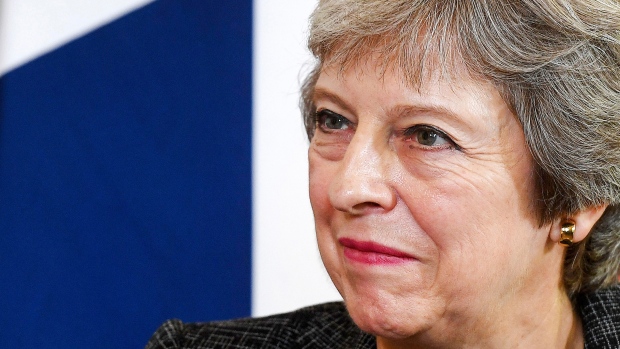Oct 15, 2018
May, Macron strike dovish tone after Brexit talks cool
, Bloomberg News

U.K. Prime Minister Theresa May struck a conciliatory tone on Brexit a day after negotiations broke down, as she joined her French counterpart in calling for cool heads to prevail.
In Brussels too, the mood was more positive 24 hours after negotiations were put on ice. A European Union diplomat told reporters the stalemate in talks was "more of a pause than a breakdown," and said the bloc isn’t ruling out progress at a leaders’ summit on Wednesday.
"I do not believe the U.K. and the EU are far apart," May told lawmakers on Monday. "The shape of a deal across the vast majority of the withdrawal agreement - the terms of our exit - are now clear."
French President Emmanuel Macron, who has taken the most hardline stance in Brexit talks, also sounded pragmatic -- he believes "collective intelligence" will prevail. He said technical talks -- which were put on hold on Sunday -- should continue and both sides want to avoid the disruption of a chaotic split.
Leaders were hoping to have the outline of an agreement ready for Wednesday, to allow the final divorce agreement to be signed off in mid-November. That is now looking ambitious, but the ball is in the leaders’ court to try and reach some kind of political compromise.
Speaking to Parliament, May avoided some of the strident rhetoric she has used recently, and crucially, didn’t repeat her line that no deal is better than a bad deal.
But while her tone was softer than it could have been, she made clear that a hard obstacle still blocks the path to a deal.
To start with, the two sides are arguing about the same issue they’ve disagreed on since February: the EU’s proposal -- which May rejects -- for a guarantee that would keep Northern Ireland in the bloc’s customs territory and single market rules indefinitely.
Not Impossible
“As things stand today, it has proven to be more complicated than some may have expected,” European Council President Donald Tusk said in a letter to EU leaders. “We should nevertheless remain hopeful and determined, as there is good will to continue these talks on both sides.”
Tusk did not sugar-coat the differences. yet stressed that they should not give up hope for a deal. “As someone rightly said: ’It always seems impossible until it’s done.’ Let us not give up,” he said. For her part, May has accepted an invitation to address leaders on Brexit at a dinner on Wednesday evening.
While agreeing on the need for a backstop, May doesn’t define it in the same way as the EU does.
May’s details
She gave a rare insight into the state of play in the talks, lifting the veil on the discussions inside the negotiating room. She said the EU accepted her rival plan for a temporary arrangement in which the whole U.K. stays in the bloc’s customs regime.
Her plan would avoid a separate set of rules for Northern Ireland and protect what she prizes most: the constitutional integrity of the U.K. But while it doesn’t object in principle, the EU complains that there’s not enough time to work up May’s blueprint, she said.
An EU diplomat signaled the problem was more complicated than that.
The other fundamental disagreement is over the British government’s desire to fix an end date to the backstop, so the country doesn’t find itself trapped indefinitely in the bloc’s customs union. The EU insists there must be a permanent backstop, with no time limit.
Even if May wanted to be flexible on this point, the debate in Parliament showed how little room she has to move. One after another, pro-Brexit members of her own party stood up to demand that she names the day when any temporary backstop will come to an end. She was warned her negotiating strategy was putting Britain on course for a national humiliation.
Her arch rival, the former Foreign Secretary Boris Johnson, put the point bluntly. Will any temporary customs regime end as she’s previously promised in December 2021, he asked, and “if that isn’t the deadline, could she say what it is?”